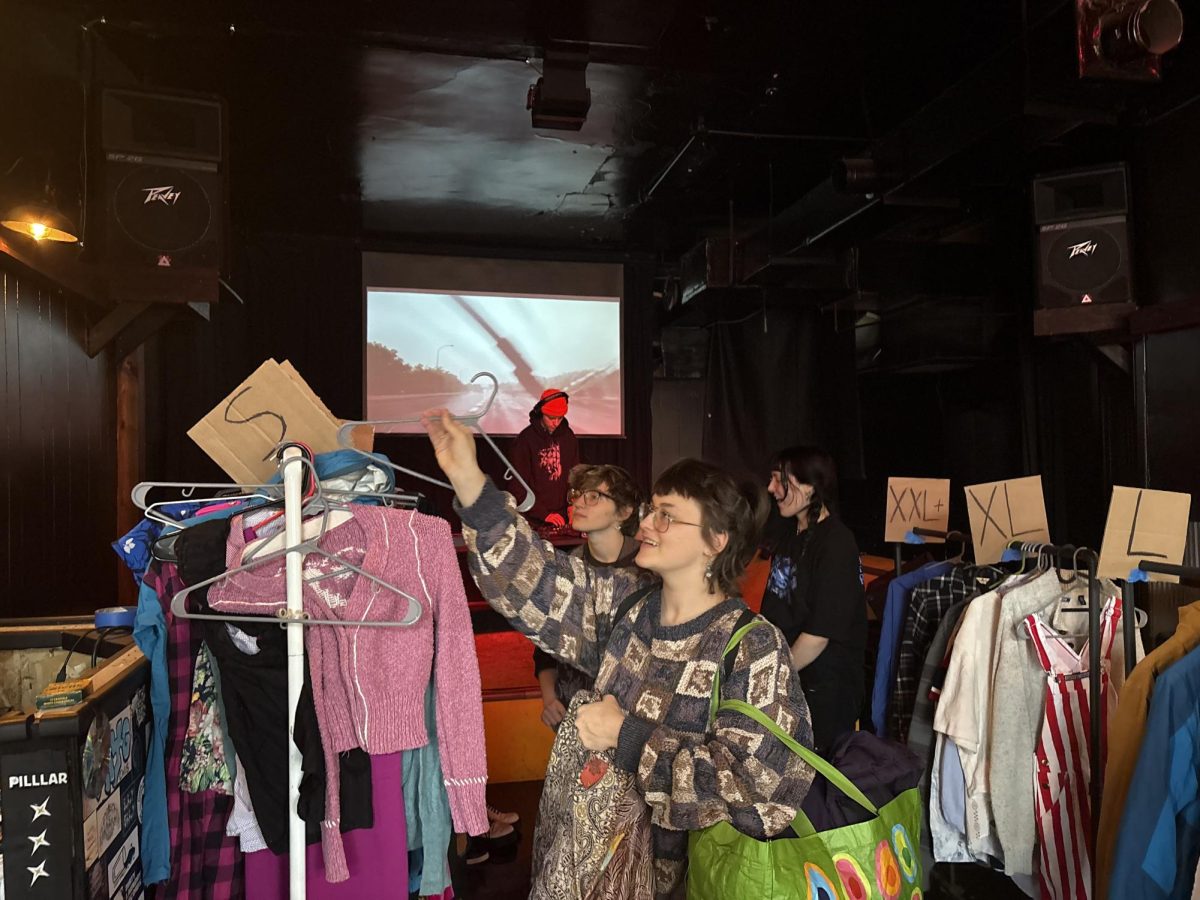Theirs is a private universe made public, an outer space both delicately and calamitously pressed together by spare parts and photo rag paper. Equal parts chaos and order, the objects and images within it come as much from sudden inner-self inventiveness as they do the longest hallways of imagination. They are the sufficiently warped dreams behind an all-too-pale reality; what artists, colleagues and friends Guy Baldwin and Gary Hallman wish could be, or others could see.
WHERE: Katherine E. Nash Gallery at the Regis Center for Art; West Bank
WHEN: Oct. 9 ñ Nov. 8
No wonder the Nash Gallery’s looming “Please Do Not Touch” signs are absolute torture. In the mechanical-visual carnival that is the “Retrospectives: Guy Baldwin & Gary Hallman” faculty exhibition of kinetic sculpture and synthetic/narrative photography, there is a performance in each piece and beating art beneath the machine. Everything begs to be touched, used, understood – but you’ll have to let your mind do the wandering. Fortunately, such ponderous reflection is much easier and more exciting than it sounds when exercised in the world of quizzical whimsy these two longstanding University instructors have woven together.
“Retrospectives” offers the rare opportunity to dig back into and survey the course of ideas and developments within two wildly creative lives; two well-established, well-respected artists whose bodies of work, academic service and teaching (in sculpture and photography, respectively) span nearly four decades. Self-curated by Baldwin and Hallman themselves, it is a show to sum up their careers as they slowly but inevitably begin to conclude them. From the wobbly starts to the revolutionary midways to the most up-to-date, it’s all here and it packs quite the punch.
Baldwin’s sculptural constructions and contraptions, inspired by things like Christmas decorations in store windows and the Erector Sets he used to tinker with as a kid, raise the stakes on science by asking whether curious, creative play can qualify alongside the forces that decide cause and effect. One walk through his magical, mischievous art junkyard is all it takes to realize the ways in which a madcap modification of objects can unearth deep emotion and sheer wonder.
Added to Baldwin’s menagerie of motion is a not-quite-musical cacophony of sound. “Pumped” greets the visitor upon entry, a painted-pink antique wheelchair piled upon with instruments and surrounded by bicycle tire pumps. Push one down – it’s immensely satisfying, being one of the only allowed interactive possibilities on display – and various notes will toot, trump, clang or whistle, courtesy of the wired-together musical treats (including a harmonica, a tuba and a duck call). “Rapsody” and “A Different Drum” follow suit in the next room, only these pieces (a grand piano and a single snare) have been thrown together to create on their own. Thanks to Baldwin’s ingenious wiring skills and an army of spindly, far-reaching wires, both are programmed to automatically give a five-minute performance every hour on the hour. It’s not terribly pretty on the ears, but it’s remarkable to observe: art, essentially coming to life.
“Even though I loved those wonderfully traditional instruments, I was a very poor piano student, much to the disappointment of my parents,” Baldwin explained. “I thought, ‘if I can’t be a good musician in the actual sense, I can be one through my sculptures.’
“I was also fascinated by the piano in Regis [wherein the Nash Gallery is located]. It’s usually used for opening receptions, in which case the hall hires a real piano player. So why not program something so we can save money and not have to?” he joked.
“Retrospectives” sheds its spotlight on Baldwin’s repeated use of fish imagery, whether through the ceiling-hung, high-flying “School” of glimmering green and pink-bellied trout or “Tackle Box,” the neon cabinet-cum-tool case covered in multiple lure-filled compartment aquariums.
At the exhibition’s heart is the new “Trojan Fish,” a massive wooden beast suspended in and literally attempting to swim out of the gallery through the main wall of windows. Its head outdoors, its body inside, the tail fins of this large-scale, skeletal structure steadily sweep back and forth, transforming the Nash into a giant fishbowl as if to officially proclaim a submersion into the alternate.
Family ties were his motivation, drawing from the trips to Chicago aquariums he would take with his mother as a boy; and from the father-son fishing trips he shared with his brother.
“My father and brother loved fishing,” Baldwin said. “Both died at an earlier age than they should have, so it’s through these sculptures of fish and tackle boxes that I can reconnect with the men in the family.”
Baldwin’s “Retrospective” partner, Gary Hallman, pulls his artwork from similar memories, and recalls being fascinated as a teenager with the family camera and the subsequent shots it produced from road trips.
“The photos from one particular vacation were terrible,” he said with a laugh. “I remember thinking to myself that there had to be more to it than this, and wondering how could I improve on error.”
That initial inkling has made Hallman’s pictorial penchants all-embracing, and the chosen “Retrospectives” prints reveal the innovation and clever, stoic handling he brings to a wide range of subjects and moods – he is that type of picture-taker who literally and figuratively looks through a different lens, his snapshots the very most visually poetic, formally abstract hopes and fears capable of transcending spoken and written language. They bounce back and forth from real to surreal, demanding all viewers expand their beliefs in order to engage new realms.
“The work in the show starts from around ’68, ’69,” Hallman said. “It was my most articulate, engaged with photographic problems, of me going beyond my expectations. It marked an exploration of the increasing necessity of technology, but I embraced it immediately – it was so potentially exciting to me.”
Giving up his darkroom in 1993 – “The year the computer fell into my life” – allowed the pioneering Hallman a switch into the vast expanse of ethereal digital art and, therefore, into the contours of human feeling previously not captured with standard portraiture.
A drift through the gallery will divulge his kaleidoscopic prints and tapestries of men in suits, moved to dance and shrouded in fans, flowers and feathers. Before long, they quietly give way to the black-and-white, character studies of years past (Diane Arbus’ haunting shots of people in their captivatingly bizarre natural habitats come to mind), and his truth-corrupting captures of eerie, barren construction zones.
Oddly enough, Hallman cites radio and television anti-hero the Lone Ranger as his final influence on a long list of painters, sculptors, photographers and architects.
“He inspired the installation of a modernistic, masculine sensibility and selfless heroism in a lot of my pieces,” said Hallman, referring to the “Icarus” series where various corporate Joes sit hunched over and consumed by layer upon layer of gigantic white wings. “His downside is also present too – as he leaves, he disconnects with people. There is a sort of disdain for community there. You can see that lack of reflection in the minds of these anonymous guys. They both represent and fall victim to those masculine values.”
Ever unstoppable, Hallman is now in what he calls “phased retirement,” where he returns to the University to teach one semester a year over a period of five years. Baldwin is embarking on a similar path, having retired a year ago but still teaching the occasional sculpture class. He is most excited for this spring semester’s kinetic instructional, where the students’ first assignment will be to salvage the Ax Man surplus store and return with their findings, prepared to make something beautifully functional.
It is befitting that the duo’s big finish before retirement truly emphasize their most brilliantly varied displays of technique and imagination. And regardless of any closing chapters, Hallman asserts that the show is not meant as final bow. This “hello show,” as he calls it, is a celebration: of each others’ accomplishments, and of the art in becoming reacquainted with works long finished in order to properly map out one’s next personal evolution.
Together, Baldwin and Hallman bring to the exhibition a renewed sense of life with all its joys and complexities and future visions. “Retrospectives” makes their serendipitous union of two completely different mediums seem gorgeously effortless, able to coexist like old comrades, the product of a valuable, time-honored partnership made of matched wits and tiny explosions of meaning.
“We walked around the gallery together while it was still empty, just brainstorming,” said Baldwin, Hallman’s longtime friend and fan. “When the time came to do the installation, we just intuitively felt out where everything was meant to go. In the end, we were very compatible.”







